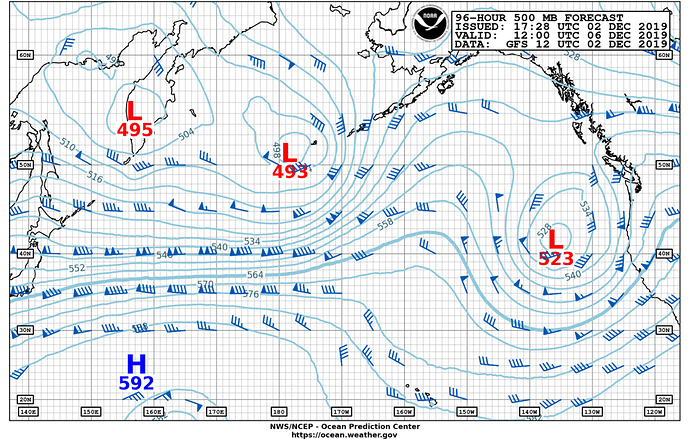
A little more on why we don’t sail offshore to Alaska.
We have a lot of ocean miles on ourselves and the boat and are capable of sailing to Alaska. However, it is not without risk. Once we leave the Straits of Juan deFuca we have a 700 mile passage to Alaska. Upwind. And up current. A voyage to windward will add 50% to the length of the trip, giving us a 10-12 day passage.
Weather forecasting is largely done via NOAA weather charts which we receive by weather fax on board our boat. This is the same information your local weather person uses to develop their forecast. Forecasting is fairly accurate for a few days, marginally accurate 4 days out, and not very dependable beyond that. On a 10 day passage, we have little accurate idea what the second week will look like.
This isn’t different from when we sailed into Japan in 2010. It was a long 10 day passage and the weather was unpredictable. We were hove to twice on that passage waiting for storms to abate. But the great advantage we had was thousands of miles of sea room. We had no worries about trying to sail off a lee shore in the middle of a storm. While the situation was uncomfortable at times, it wasn’t dangerous.
Now consider the west coast of North American. Known as the Graveyard of the Pacific, it is a coastline notorious for severe weather and unforgiving geography. We could leave during a weather window that guaranteed a good first week, but those lows coming off of China roll across the Pacific and into the Gulf of Alaska. Getting halfway through the trip and then discovering a storm is heading our way leaves few choices, none of them good.
If you stayed close enough to shore, you could run for a protected harbor. If there is a protected harbor nearby. And it’s open to you. Or you could head further offshore to give yourself more sea room, duplicating our experience sailing into Japan. Problem is, before you leave you need to decide the most likely course of action in bad weather and position your boat accordingly. And how much is enough sea room? 100 miles? 200 miles?
It is tricky. When we left Alaska in 2006 to sail offshore to the Straits we were using a weather router. It took a week for a weather window to come up and we had two days to leave or miss it and wait an estimated 2 weeks longer for another window. There are summer gales and challenging weather all summer along this coast. If this seems like a lot to consider and prepare for, it is. While I’d love to spend a couple of months in Alaska, just not sure its worth the effort to sail offshore to get there.